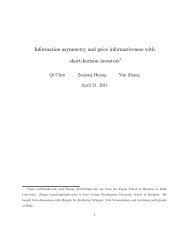Does Enforcement of Intellectual Property Rights Matter in China ...
Does Enforcement of Intellectual Property Rights Matter in China ...
Does Enforcement of Intellectual Property Rights Matter in China ...
You also want an ePaper? Increase the reach of your titles
YUMPU automatically turns print PDFs into web optimized ePapers that Google loves.
variables, are lagged by one year.<br />
The standard errors are robust to corrections for<br />
heteroskedasticity and with<strong>in</strong>-prov<strong>in</strong>ce correlations.<br />
Insert Table 5<br />
The coefficients and z-stat obta<strong>in</strong>ed from the OLS estimation <strong>of</strong> Equation (2), us<strong>in</strong>g IPP1 as the<br />
measure <strong>of</strong> IP enforcement, are presented <strong>in</strong> Column 1 <strong>in</strong> Table 5. The coefficients on the<br />
<strong>in</strong>teraction terms between IP rights enforcement and fund<strong>in</strong>g from new debt, and between IP rights<br />
enforcement and <strong>in</strong>ternal f<strong>in</strong>anc<strong>in</strong>g are positive and significant. The results suggest that <strong>in</strong><br />
prov<strong>in</strong>ces with better IP rights enforcement, high tech companies will <strong>in</strong>vest a significantly higher<br />
proportion <strong>of</strong> new debt and new <strong>in</strong>ternal f<strong>in</strong>anc<strong>in</strong>g <strong>in</strong> R&D. When mov<strong>in</strong>g from the lowest-IPP1<br />
prov<strong>in</strong>ce to highest-IPP1 prov<strong>in</strong>ce, the percentage <strong>of</strong> new debt <strong>in</strong>vested <strong>in</strong> R&D more than doubles,<br />
from 3.1% to 8.5%, while the percentage <strong>of</strong> new <strong>in</strong>ternal f<strong>in</strong>anc<strong>in</strong>g <strong>in</strong>vested <strong>in</strong> R&D rises from<br />
9.2% to 20.6%.<br />
The results above are robust to controll<strong>in</strong>g for other prov<strong>in</strong>cial characteristics (Column 2). We<br />
also re-estimate the basic model <strong>in</strong> Column 1 by controll<strong>in</strong>g for the <strong>in</strong>teractions between the<br />
prov<strong>in</strong>cial characteristics and the three fund<strong>in</strong>g sources. The estimated coefficients <strong>of</strong> the<br />
<strong>in</strong>teraction terms between IP rights enforcement and new debt, and between IP rights enforcement<br />
and new <strong>in</strong>ternal f<strong>in</strong>ance, rema<strong>in</strong> positive and statistically significant (not tabulated). The results are<br />
robust when we use IPP2 to measure IP enforcement (Column 4 and Column 5). The results do not<br />
change qualitatively <strong>in</strong> the <strong>in</strong>strumental variable regressions (Column 3 and Column 6).<br />
4.3 The effect <strong>of</strong> IP rights enforcement on R&D output<br />
We now <strong>in</strong>vestigate the impact <strong>of</strong> IP rights enforcement on R&D output. The first measure <strong>of</strong><br />
R&D output is the number <strong>of</strong> <strong>in</strong>novation patents. The number <strong>of</strong> <strong>in</strong>novation patents is predicted to<br />
27



